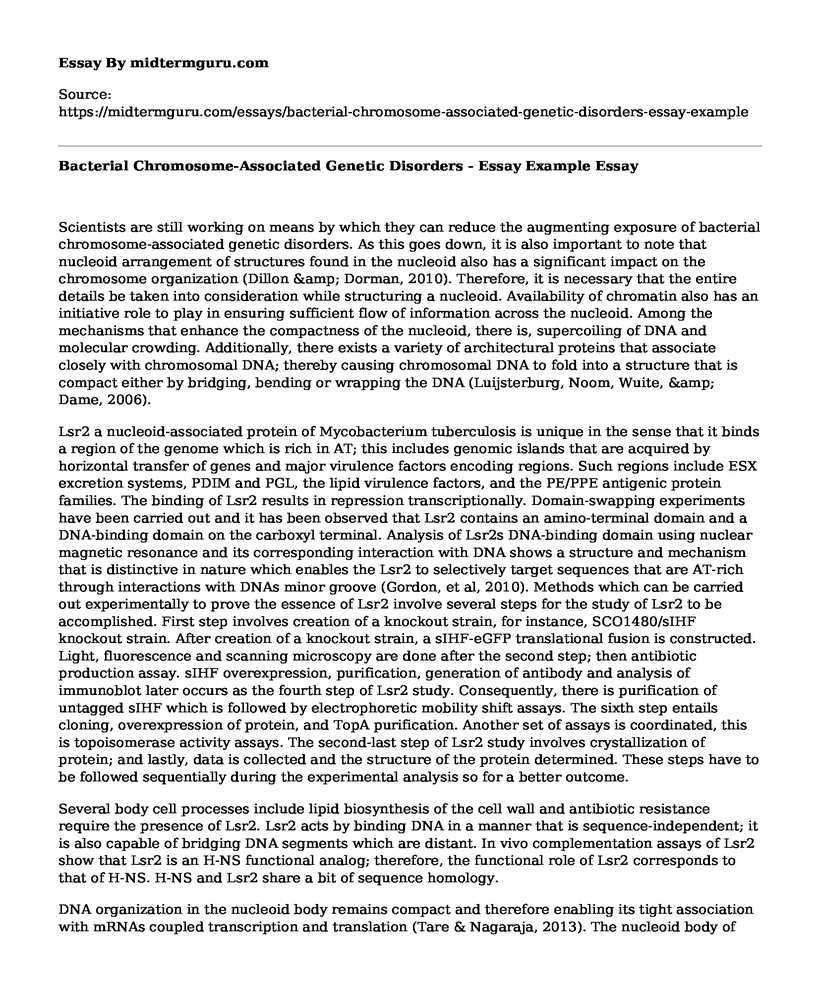Scientists are still working on means by which they can reduce the augmenting exposure of bacterial chromosome-associated genetic disorders. As this goes down, it is also important to note that nucleoid arrangement of structures found in the nucleoid also has a significant impact on the chromosome organization (Dillon & Dorman, 2010). Therefore, it is necessary that the entire details be taken into consideration while structuring a nucleoid. Availability of chromatin also has an initiative role to play in ensuring sufficient flow of information across the nucleoid. Among the mechanisms that enhance the compactness of the nucleoid, there is, supercoiling of DNA and molecular crowding. Additionally, there exists a variety of architectural proteins that associate closely with chromosomal DNA; thereby causing chromosomal DNA to fold into a structure that is compact either by bridging, bending or wrapping the DNA (Luijsterburg, Noom, Wuite, & Dame, 2006).
Lsr2 a nucleoid-associated protein of Mycobacterium tuberculosis is unique in the sense that it binds a region of the genome which is rich in AT; this includes genomic islands that are acquired by horizontal transfer of genes and major virulence factors encoding regions. Such regions include ESX excretion systems, PDIM and PGL, the lipid virulence factors, and the PE/PPE antigenic protein families. The binding of Lsr2 results in repression transcriptionally. Domain-swapping experiments have been carried out and it has been observed that Lsr2 contains an amino-terminal domain and a DNA-binding domain on the carboxyl terminal. Analysis of Lsr2s DNA-binding domain using nuclear magnetic resonance and its corresponding interaction with DNA shows a structure and mechanism that is distinctive in nature which enables the Lsr2 to selectively target sequences that are AT-rich through interactions with DNAs minor groove (Gordon, et al, 2010). Methods which can be carried out experimentally to prove the essence of Lsr2 involve several steps for the study of Lsr2 to be accomplished. First step involves creation of a knockout strain, for instance, SCO1480/sIHF knockout strain. After creation of a knockout strain, a sIHF-eGFP translational fusion is constructed. Light, fluorescence and scanning microscopy are done after the second step; then antibiotic production assay. sIHF overexpression, purification, generation of antibody and analysis of immunoblot later occurs as the fourth step of Lsr2 study. Consequently, there is purification of untagged sIHF which is followed by electrophoretic mobility shift assays. The sixth step entails cloning, overexpression of protein, and TopA purification. Another set of assays is coordinated, this is topoisomerase activity assays. The second-last step of Lsr2 study involves crystallization of protein; and lastly, data is collected and the structure of the protein determined. These steps have to be followed sequentially during the experimental analysis so for a better outcome.
Several body cell processes include lipid biosynthesis of the cell wall and antibiotic resistance require the presence of Lsr2. Lsr2 acts by binding DNA in a manner that is sequence-independent; it is also capable of bridging DNA segments which are distant. In vivo complementation assays of Lsr2 show that Lsr2 is an H-NS functional analog; therefore, the functional role of Lsr2 corresponds to that of H-NS. H-NS and Lsr2 share a bit of sequence homology.
DNA organization in the nucleoid body remains compact and therefore enabling its tight association with mRNAs coupled transcription and translation (Tare & Nagaraja, 2013). The nucleoid body of bacteria abundantly contains DNA-binding proteins that perform regulatory and structural roles. In Escherichia coli, the nucleoid body serves the role of buffering and organizing pervasive DNA superhelicity (Rimsky and Travers, 2011). With comparison to this case, it can be noted that NAPs have a role in coordinating gene expression regulation and superhelicity both at the local level (which corresponds to the activity of the promoter and recombination of genetics) and global level (or chromosomal level). To determine how DNA is packaged in the nucleoid experimentally, in vivo digestion of DNA is used along with digestion-resistant fragments high-throughput sequencing. As soon as this is done, E. coli cells will be automatically transformed with a plasmid; but now, the plasmid will express micrococcal nuclease. AraC repressor influences the expression of micrococcal nuclease. Systems which undergo repression inhibit synthesis of messenger RNAs by blocking RNA polymerase attachment to the promoter. The repressor mostly acts on the operons by binding to the operator.
Expected output and outcome of the proposal: After conducting the research, the proposed studies in deep lengths would allow me to be able to understand the various roles played by nucleoid-associated proteins in gene expression and chromosome organization. Nucleoid-associated proteins have important functions in bacterial organisms, thus their absence will make the survival mechanism and span of bacterial organisms to be limited. Among the various roles outlined, it is evident that H-NS would be of so much significance in the nucleoids as it will ensure gene regulation for genes that are more sensitive to environmental change (Wade, Struhl, Busby, & Grainger, 2007).
Other proteins can also perform the functions of nucleoid-associated proteins such as H-NS; an example for this case is a Lacl protein which is from E. coli. Lacl protein is responsible for repression of transcription of the lac operon. Lacl protein is a tetramer and therefore, it can stably form bridges in between...
Cite this page
Bacterial Chromosome-Associated Genetic Disorders - Essay Example. (2021, Jun 04). Retrieved from https://midtermguru.com/essays/bacterial-chromosome-associated-genetic-disorders-essay-example
If you are the original author of this essay and no longer wish to have it published on the midtermguru.com website, please click below to request its removal:
- The Work Plan for Having a Mosquito Control Program
- Essay Sample on Nutrition
- Assignment Example on Ecstasy
- Holistic Nursing Care: Women's Health & Humanistic Theory - Research Paper
- Diabetes Mellitus: Prevalence, Self-Management & Control - Essay Sample
- Jensen Pharma Announces 3-Month Investigation of Dekanor - Essay Sample
- Paper Example on Darwin's Theory of Evolution







